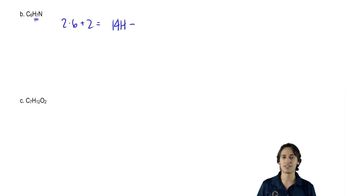Here are the essential concepts you must grasp in order to answer the question correctly.
Hydrocarbon Structure
Hydrocarbons are organic compounds consisting solely of carbon (C) and hydrogen (H) atoms. Their structure can vary significantly based on the types of bonds (single, double, or triple) and the presence of rings. Understanding the basic structure of hydrocarbons is essential for determining their molecular formula, as the arrangement and types of bonds influence the overall composition.
Recommended video:
Aromaticity of Hydrocarbons
Degree of Unsaturation
The degree of unsaturation indicates the total number of rings and multiple bonds (double or triple) in a hydrocarbon. Each double bond or ring contributes one degree of unsaturation, while each triple bond contributes two. This concept is crucial for calculating the molecular formula, as it helps determine how many hydrogen atoms are present relative to the number of carbon atoms.
Recommended video:
The difference between saturated and unsaturated molecules.
Molecular Formula Calculation
The molecular formula of a compound represents the number and types of atoms present. For hydrocarbons, the general formula is CnH(2n+2) for saturated compounds. However, for unsaturated hydrocarbons, adjustments must be made based on the degree of unsaturation. In this case, the presence of 1 triple bond, 2 double bonds, and 1 ring must be accounted for to derive the correct molecular formula from the given number of carbon atoms.
Recommended video:
Calculating IHD using molecular formula
 Verified step by step guidance
Verified step by step guidance Verified video answer for a similar problem:
Verified video answer for a similar problem:



 2:39m
2:39m